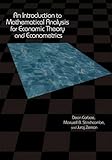An Introduction to Mathematical Analysis for Economic Theory and Econometrics / Dean Corbae, Maxwell B. Stinchcombe, Juraj Zeman.
Material type: TextPublisher: Princeton, NJ : Princeton University Press, [2009]Copyright date: ©2009Description: 1 online resource (688 p.) : 55 line illusContent type:
TextPublisher: Princeton, NJ : Princeton University Press, [2009]Copyright date: ©2009Description: 1 online resource (688 p.) : 55 line illusContent type: - 9781400833085
- Business
- Econometrics
- Economics, Mathematical
- Mathematical analysis
- BUSINESS & ECONOMICS / Econometrics
- Approximation
- Axiom of choice
- Banach space
- Bijection
- Bounded function
- Budget set
- Calculation
- Cardinality
- Cauchy sequence
- Central limit theorem
- Combination
- Compact space
- Complete metric space
- Concave function
- Conditional expectation
- Continuous function (set theory)
- Continuous function
- Contraction mapping
- Contradiction
- Convex analysis
- Convex set
- Countable set
- Dense set
- Differentiable function
- Dimension (vector space)
- Dimension
- Division by zero
- Dynamic programming
- Empty set
- Equation
- Equivalence class
- Estimator
- Existential quantification
- Finite set
- Fixed-point theorem
- Function (mathematics)
- Hahn–Banach theorem
- Independence (probability theory)
- Indicator function
- Inequality (mathematics)
- Infimum and supremum
- Intermediate value theorem
- Karush–Kuhn–Tucker conditions
- Law of large numbers
- Lebesgue measure
- Limit of a sequence
- Limit superior and limit inferior
- Linear algebra
- Linear function
- Linear map
- Linear subspace
- Loss function
- Markov chain
- Mathematical optimization
- Mathematics
- Maximal element
- Measurable function
- Measure (mathematics)
- Metric space
- Monotonic function
- Normed vector space
- Null set
- Open set
- Optimization problem
- Parameter
- Pareto efficiency
- Partially ordered set
- Preference (economics)
- Preference relation
- Probability distribution
- Probability space
- Probability theory
- Probability
- Quantity
- Random variable
- Rational number
- Real number
- Scientific notation
- Sequence
- Set (mathematics)
- Simple function
- Special case
- Stochastic process
- Stone–Weierstrass theorem
- Subsequence
- Subset
- Summation
- Surjective function
- Theorem
- Topological space
- Topology
- Uncountable set
- Uniform continuity
- Uniform distribution (discrete)
- Union (set theory)
- Upper and lower bounds
- Utility
- Variable (mathematics)
- Vector space
- Zorn's lemma
- 330.015195
- HB135 .C657 2011
- online - DeGruyter
| Item type | Current library | Call number | URL | Status | Notes | Barcode | |
|---|---|---|---|---|---|---|---|
 eBook
eBook
|
Biblioteca "Angelicum" Pont. Univ. S.Tommaso d'Aquino Nuvola online | online - DeGruyter (Browse shelf(Opens below)) | Online access | Not for loan (Accesso limitato) | Accesso per gli utenti autorizzati / Access for authorized users | (dgr)9781400833085 |
Frontmatter -- Contents -- Preface -- User’s Guide -- Notation -- CHAPTER 1 Logic -- CHAPTER 2 Set Theory -- CHAPTER 3 The Space of Real Numbers -- CHAPTER 4 The Finite-Dimensional Metric Space of Real Vectors -- CHAPTER 5 Finite-Dimensional Convex Analysis -- CHAPTER 6 Metric Spaces -- CHAPTER 7 Measure Spaces and Probability -- CHAPTER 8 The Lp ( Ω, F, P) and lp Spaces, p ∈ [1,∞] -- CHAPTER 9 Probabilities on Metric Spaces -- CHAPTER 10 Infinite-Dimensional Convex Analysis -- CHAPTER 11 Expanded Spaces -- Index
restricted access online access with authorization star
http://purl.org/coar/access_right/c_16ec
Providing an introduction to mathematical analysis as it applies to economic theory and econometrics, this book bridges the gap that has separated the teaching of basic mathematics for economics and the increasingly advanced mathematics demanded in economics research today. Dean Corbae, Maxwell B. Stinchcombe, and Juraj Zeman equip students with the knowledge of real and functional analysis and measure theory they need to read and do research in economic and econometric theory. Unlike other mathematics textbooks for economics, An Introduction to Mathematical Analysis for Economic Theory and Econometrics takes a unified approach to understanding basic and advanced spaces through the application of the Metric Completion Theorem. This is the concept by which, for example, the real numbers complete the rational numbers and measure spaces complete fields of measurable sets. Another of the book's unique features is its concentration on the mathematical foundations of econometrics. To illustrate difficult concepts, the authors use simple examples drawn from economic theory and econometrics. Accessible and rigorous, the book is self-contained, providing proofs of theorems and assuming only an undergraduate background in calculus and linear algebra. Begins with mathematical analysis and economic examples accessible to advanced undergraduates in order to build intuition for more complex analysis used by graduate students and researchers Takes a unified approach to understanding basic and advanced spaces of numbers through application of the Metric Completion Theorem Focuses on examples from econometrics to explain topics in measure theory
Mode of access: Internet via World Wide Web.
In English.
Description based on online resource; title from PDF title page (publisher's Web site, viewed 01. Dez 2022)


